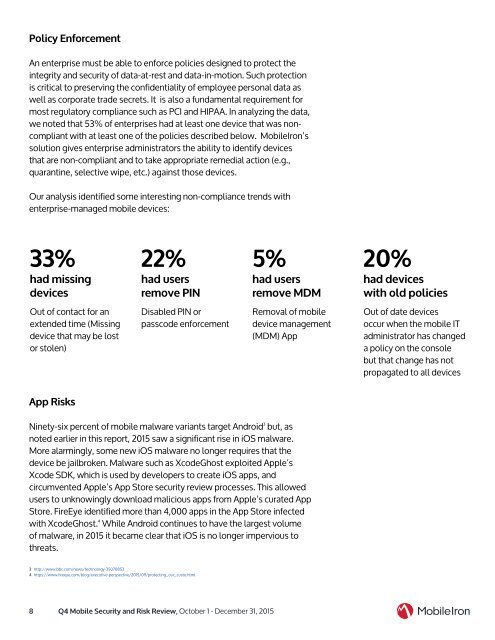Q4 Mobile Security and Risk Review
security-report-Q415-v1.2-EN
security-report-Q415-v1.2-EN
You also want an ePaper? Increase the reach of your titles
YUMPU automatically turns print PDFs into web optimized ePapers that Google loves.
Policy Enforcement<br />
An enterprise must be able to enforce policies designed to protect the<br />
integrity <strong>and</strong> security of data-at-rest <strong>and</strong> data-in-motion. Such protection<br />
is critical to preserving the confidentiality of employee personal data as<br />
well as corporate trade secrets. It is also a fundamental requirement for<br />
most regulatory compliance such as PCI <strong>and</strong> HIPAA. In analyzing the data,<br />
we noted that 53% of enterprises had at least one device that was noncompliant<br />
with at least one of the policies described below. <strong>Mobile</strong>Iron’s<br />
solution gives enterprise administrators the ability to identify devices<br />
that are non-compliant <strong>and</strong> to take appropriate remedial action (e.g.,<br />
quarantine, selective wipe, etc.) against those devices.<br />
Our analysis identified some interesting non-compliance trends with<br />
enterprise-managed mobile devices:<br />
33%<br />
had missing<br />
devices<br />
22%<br />
had users<br />
remove PIN<br />
5%<br />
had users<br />
remove MDM<br />
20%<br />
had devices<br />
with old policies<br />
Out of contact for an<br />
extended time (Missing<br />
device that may be lost<br />
or stolen)<br />
Disabled PIN or<br />
passcode enforcement<br />
Removal of mobile<br />
device management<br />
(MDM) App<br />
Out of date devices<br />
occur when the mobile IT<br />
administrator has changed<br />
a policy on the console<br />
but that change has not<br />
propagated to all devices<br />
App <strong>Risk</strong>s<br />
Ninety-six percent of mobile malware variants target Android 3 but, as<br />
noted earlier in this report, 2015 saw a significant rise in iOS malware.<br />
More alarmingly, some new iOS malware no longer requires that the<br />
device be jailbroken. Malware such as XcodeGhost exploited Apple’s<br />
Xcode SDK, which is used by developers to create iOS apps, <strong>and</strong><br />
circumvented Apple’s App Store security review processes. This allowed<br />
users to unknowingly download malicious apps from Apple’s curated App<br />
Store. FireEye identified more than 4,000 apps in the App Store infected<br />
with XcodeGhost. 4 While Android continues to have the largest volume<br />
of malware, in 2015 it became clear that iOS is no longer impervious to<br />
threats.<br />
3 http://www.bbc.com/news/technology-35070853<br />
4 https://www.fireeye.com/blog/executive-perspective/2015/09/protecting_our_custo.html<br />
8 <strong>Q4</strong> <strong>Mobile</strong> <strong>Security</strong> <strong>and</strong> <strong>Risk</strong> <strong>Review</strong>, October 1 - December 31, 2015






